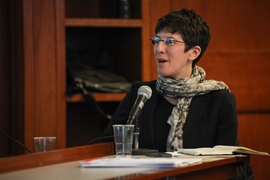A gathering of MIT students, faculty, staff, and alumni took part Thursday in series of talks, polling questions, and brainstorming sessions aimed at spurring the whole MIT community to engage in the process of making the Institute a world leader, role model, and catalyst for how campuses around the world can work to reduce their carbon footprint and create a more sustainable environment.
The event, billed as “Creating the Roadmap: Envisioning/Reducing MIT's Carbon Footprint,” began with talks outlining the MIT campus’ current energy usage and emissions, and the presentation of plans for new buildings and renovations that could have an impact on energy use. During the talks, participants had a chance to register their responses to questions about both factual information on campus energy use and opinions about priorities for improving things. Then, the group broke into small teams for brainstorming about suggestions on specific measures to reduce campus greenhouse-gas emissions.
“We’re here to engage you all in renewing the campus in a sustainable manner,” said Israel Ruiz, MIT’s executive vice president and treasurer, who initiated MIT’s creation two years ago of an Office of Sustainability. “It’s an issue I care a lot about,” he said, “how we’re actually going to change the world through what we do here.”
Ruiz pointed out that the campus already faces the need to carry out about $2 billion worth of renovations on its existing buildings over the next five to 10 years, but that need also presents a great opportunity for improving the overall energy efficiency of the campus.
In addition, he said, MIT has “a lot of great research where we can use the campus for experiments,” and potentially find innovations that other institutions can emulate.
Introducing the event, Christoph Reinhart, a professor of architecture, said the idea was to “seek broad input and see how MIT can respond” to the challenge of climate change, “and what we can do as a community” to address our own energy usage. “Based on this input, we will write a final report,” he said, and over the next few months all members of the MIT community are encouraged to submit suggestions and comments online, which need not be fully thought out or detailed.
MIT has 171 buildings totaling 12 million square feet of space, he said. Though that’s a minuscule footprint by global standards, how MIT manages its own facilities could have a disproportionate impact, he said: “We see ourselves as a catalyst for change, and there are a lot of people in the world looking at what we do.” If the Institute can find solutions on campus that are scalable and replicable, he said, “we can have an influence.”
Henry “Jake” Jacoby, professor emeritus of management, underscored that point, saying “MIT is really small, but in terms of demonstrating what can be done, it’s really important.” He suggested that one critical step would be to change the way accounting is done so that different departments and labs would explicitly have to account for their energy use in their own budgets, giving them a direct incentive to find more efficient approaches.
It’s essential, Jacoby added, given MIT’s reputation in the world, that “we don’t do things that are symbolic but don’t have a real effect.” It’s important to “not just do it, but do it right.”
In moving toward innovative solutions, one key aspect for a data-driven place like MIT is to improve the ability to collect detailed energy use data at a building-by-building level or better, and that process is already well underway, said Sarah Bylinsky, a program manager in the sustainability office. “We can’t manage what we can’t measure,” she said.
In making MIT into a world-leading example of how to maximize efficiency and minimize its impact on climate, Ruiz said that “the willingness is there, and there’s a full menu of opportunities.” Now, he said, it’s up to all the members of the MIT family to “help us choose what’s most effective for our community.”
In looking for innovative solutions, Bylinsky said, “we have to embolden ourselves. We shouldn’t be afraid to think big, beyond our current capacity, and to do as much as we can.”















